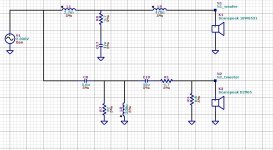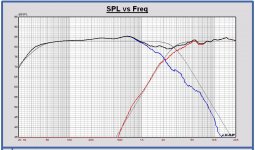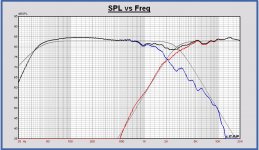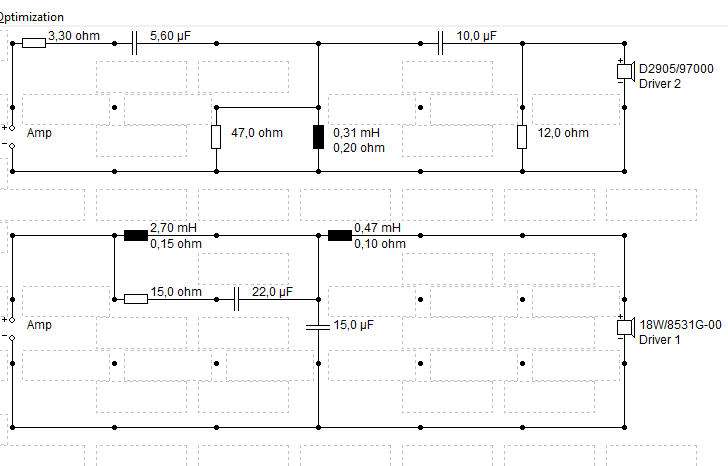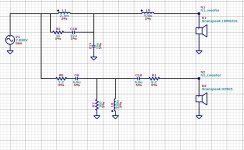Reset all, Paul: the issuw is not the baffle step. I just read that this woofer has a resonance on 800hz , as you can see drom rh datasheet. There is a small peak on impedance in 800hz ( that i measured).
The impedance blip is a suspension issue and causes the dip (not a bump) at around 750Hz. It is not causing your reported mid issues. The very likely cause is poor crossover implementation, nothing else. The bump you see at 800Hz on the dibirama files is a baffle diffraction product.
I will sugest something else. Scrap the project and buy a set of good waveguides, the newer Visaton waveguide looks very good, the Monacor WG300 is excellent as are the waveguides made by Dave Pellegrene. The 9700 tweeter is pretty concave and will have issues above 10Khz but for example the WG300 would allow you to crossover even lower and will help kill the tweeter baffle diffraction. WG300 would pull the tweeter about 34mm backwards and voice coils will allign physically so easier and better crossover would be possible with lower overall distortion and better dynamics. The db boost of the wg would also equalise the rising response of the 9700. Not sure if Paul can simulate waveguide loaded design, I`m not familiar with Leap.
Ok! I think is correct leap woofer, no doubt.
Curiosity, would you simulate 2.7mh/12uf-4.7ohm to ground/0.47mh? Dcr of inductor is very low
0.11ohm for 2.7mh and 0.19 ohm for 0.47mh
Curiosity, would you simulate 2.7mh/12uf-4.7ohm to ground/0.47mh? Dcr of inductor is very low
0.11ohm for 2.7mh and 0.19 ohm for 0.47mh
The impedance blip is a suspension issue and causes the dip (not a bump) at around 750Hz. It is not causing your reported mid issues. The very likely cause is poor crossover implementation, nothing else. The bump you see at 800Hz on the dibirama files is a baffle diffraction product.
I will sugest something else. Scrap the project and buy a set of good waveguides, the newer Visaton waveguide looks very good, the Monacor WG300 is excellent as are the waveguides made by Dave Pellegrene. The 9700 tweeter is pretty concave and will have issues above 10Khz but for example the WG300 would allow you to crossover even lower and will help kill the tweeter baffle diffraction. WG300 would pull the tweeter about 34mm backwards and voice coils will allign physically so easier and better crossover would be possible with lower overall distortion and better dynamics. The db boost of the wg would also equalise the rising response of the 9700. Not sure if Paul can simulate waveguide loaded design, I`m not familiar with Leap.
Hi Mario,
I understand your comments, but this is a good analysis to understand what is going wrong with this concept. And maybe Cucicu gets out of the problem.
I agree using a waveguide in a speaker. In combination with a 7 or 8 inch, it is almost a need to realize a good power transition between mid and high.
I cannot make a waveguide model in Leap. I have to measure it on my IEC baffle on different angles and make the best simulation possible in Leap with these.
I am thinking of buying Fast BEM to simulate such applications, it is very powerful.
The Seas DXT H1499 has also a little waveguide that starts working above 3kHz. I have made a design of this tweeter in a speaker of a friend of me. It is a very good tweeter for its money. Also used in the Grimm Audio LS1.
Last edited:
ok.
But it would be possible to have leap file for the woofer, so you can relax ?? :=)
Paul, last thing I ask you, here rabbitz posted this series crossover. If you coul simulate, it will be great. He says it is a great speaker that way. Could you?
http://www.diyaudio.com/forums/mult...8w8531-d2905-97000-crossover.html#post5015750
But it would be possible to have leap file for the woofer, so you can relax ?? :=)
Paul, last thing I ask you, here rabbitz posted this series crossover. If you coul simulate, it will be great. He says it is a great speaker that way. Could you?
http://www.diyaudio.com/forums/mult...8w8531-d2905-97000-crossover.html#post5015750
ok.
But it would be possible to have leap file for the woofer, so you can relax ?? :=)
[/url]
Sure, no problem and very good idea 🙂. That works faster too.
View attachment Leap woofer frd.zip
ok.
Paul, last thing I ask you, here rabbitz posted this series crossover. If you coul simulate, it will be great. He says it is a great speaker that way. Could you?
http://www.diyaudio.com/forums/mult...8w8531-d2905-97000-crossover.html#post5015750
Cucicu,
It is a LR2 at 2000Hz, well behaving around the crossover point, good phase aligning too. But boost around 700-800Hz with both the dibirama as the Leap frd's. My first impression, it looks like that the baffle boost around 800Hz is not taken into account.
Schematic filter29 Rabbitz LR2 2000Hz
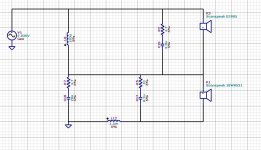
SPL filter29 Rabbitz LR2 2000Hz Leap woofer frd and dibirama tweeter frd
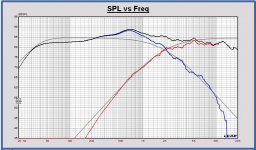
SPL filter29 Rabbitz LR2 2000Hz all dibirama frd
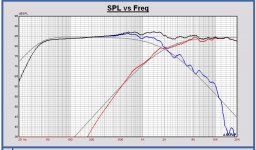
Do you think the baffle boost is adjustable?
Not so difficult and two components can be deleted.
Phase aligning is ok for woofer and tweeter aligned. With woofer 20mm behind, the SPL and phase aligning are a little worse, but ok.
Optimized with dibirama frd's.
Schematic filter 30 serial LR2 2000
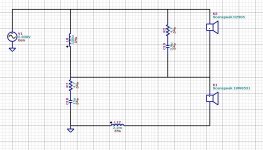
SPL filter 30 serial LR2 2000 all dibirama frd
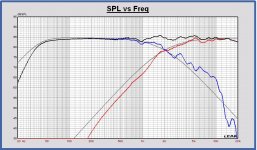
For the best result with woofer Leap frd, L12 has to be increased to 3.3mH, but the response is not so good on target.
SPL filter 30 serial LR2 2000 Leap woofer frd and dibirama tweeter frd
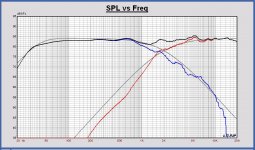
I think you have now a lot to try out... 🙂
And what is best sounding at the moment ?
Yes🙂
I tried each filter 😉
The best sounding till now is yours 27 xover with minor mods. It sound very equilibrated but the tweeter is not airy.... this is with every filter tried.
I think there is an issue on the tweeter because it always sounds "dark". No sibilance here, and its ok, but also padded with only 1ohm it always sounds dark. I think that if you manage to understand why, we have made a top perfomer speaker.
Right now, with 27 filter, bass is superb, midrange is clear and sweet, but the tweeter, despite its rising response, sounds dark. I hope you can explain this because i am going mad 🙁
I tried each filter 😉
The best sounding till now is yours 27 xover with minor mods. It sound very equilibrated but the tweeter is not airy.... this is with every filter tried.
I think there is an issue on the tweeter because it always sounds "dark". No sibilance here, and its ok, but also padded with only 1ohm it always sounds dark. I think that if you manage to understand why, we have made a top perfomer speaker.
Right now, with 27 filter, bass is superb, midrange is clear and sweet, but the tweeter, despite its rising response, sounds dark. I hope you can explain this because i am going mad 🙁
if you put a coil of ca. 0.10mh in series at tweeter, before the first resistence of 3.3ohm, frequencies from 4 to 8khz rise of 1-1.5db but the FR drops of 5-6db's after 10khz.
if you put a coil of ca. 0.10mh in series at tweeter, before the first resistence of 3.3ohm, frequencies from 4 to 8khz rise of 1-1.5db but the FR drops of 5-6db's after 10khz.
Cucicu,
Without looking to the SPL try this filter. It is your last schematic but tweeter filter modified in a certain way. But first listen and tell me what the difference is, if it goes the good or bad way for that tweeter. After listening you can simulate the response of course. But listen first otherwise you are already brainwashed 🙂. It is a kind of blind test.
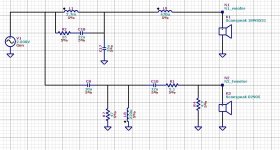
Ok. But I suspect that this tweeter is not good for me, maybe the 33mm diameter is to big and sounds not refined as I would like.
Eventually, is there any suitable tweeter substitute that can fit the the holes dimension on my baffle? I m gonna having a search of same dimension flange tweeter, maybe you can suggest one
Eventually, is there any suitable tweeter substitute that can fit the the holes dimension on my baffle? I m gonna having a search of same dimension flange tweeter, maybe you can suggest one
Paul
If can help, from the many proofs I have made, the tweeter sounds "good" to me, only when filtered with a 3rd order and not more than 3.3uf/0.25mH/4.7uf.
Best with 2.2uf/0.25mH/4.7uf. I don't know why, but if the first capacitor is larger than 3.3uf, the tweeter sounds too midy and dark.
So, it's for this reason that I would like to make the woofer sounding as higher that it is possible.
I think we shoul try this direction...could you try to simulate something like that? maybe a 4th order on woofer and a 3rd order on tweeter is the solution
thank you
If can help, from the many proofs I have made, the tweeter sounds "good" to me, only when filtered with a 3rd order and not more than 3.3uf/0.25mH/4.7uf.
Best with 2.2uf/0.25mH/4.7uf. I don't know why, but if the first capacitor is larger than 3.3uf, the tweeter sounds too midy and dark.
So, it's for this reason that I would like to make the woofer sounding as higher that it is possible.
I think we shoul try this direction...could you try to simulate something like that? maybe a 4th order on woofer and a 3rd order on tweeter is the solution
thank you
Last edited:
look at this for example. it has been a genius lamp 🙂

phase seems very good, also power response. Also varying 1st inductor and first cap on the woofer (to 2.2mh or 2.7mh and 4.7uf for exmple) phase tracking remains the same (great reverse null) , they manage baffle step compensation. what do you think?

phase seems very good, also power response. Also varying 1st inductor and first cap on the woofer (to 2.2mh or 2.7mh and 4.7uf for exmple) phase tracking remains the same (great reverse null) , they manage baffle step compensation. what do you think?
Looking to this filter response, more and more it looks you are missing high frequency power using the standard filter designs. Maybe yes, it is that 33mm tweeter that has more beaming and less power than a 25mm one.
The Seas DXT H1499 has the same flange diameter as yours but is 6mm thick. This tweeter is used in the Grimm Audio LS1. I have made a design with it for a friend of me, with good results. It is a not an expensive speaker, very good for its money. It has a little waveguide for more beaming above 3000Hz and has the DXT principle to give more expansion above 10kHz.
The Scanspeak D3004-660000 is also a good one. It is the soft dome version of their Berylium D3004-664000. Also 6mm thick flange, same diameter. The Be version is used in the Magico speakers, very good, I have heard them. The soft dome version is used in the YG Acoustics Carmel 2 with a waveguide. I have not heard myself but a friend of me tells that this speaker sounds extremely good.
The Seas DXT H1499 has the same flange diameter as yours but is 6mm thick. This tweeter is used in the Grimm Audio LS1. I have made a design with it for a friend of me, with good results. It is a not an expensive speaker, very good for its money. It has a little waveguide for more beaming above 3000Hz and has the DXT principle to give more expansion above 10kHz.
The Scanspeak D3004-660000 is also a good one. It is the soft dome version of their Berylium D3004-664000. Also 6mm thick flange, same diameter. The Be version is used in the Magico speakers, very good, I have heard them. The soft dome version is used in the YG Acoustics Carmel 2 with a waveguide. I have not heard myself but a friend of me tells that this speaker sounds extremely good.
Last edited:
Thank you i will have a look.
With 0.10mh inductor response of tweeter is more detailed than without it. Maybe it makes a drop over 20khz but in general i am preferring with it.
I had an issue with tweeter level. Finally I manged to allign woofer . Could you simulate this? Now it s good but at fft measurement I have a bump on 4khz-10khz and can t understand if it is a mic issue or the reality.
Xover is (sorry i cant attach images at the moment):
Woofer 4rth order: 2.7mh with 47ohm in parallel/4.7uf to gnd/ 2.2 mh/6.8uf to gnd
Tweeter: 0.10mh-5.1ohm-3.3uf/0.25mh to gnd-6.8uf.
This config is alligned and no more woofer issues but maybe there is a phase problem in the crossing point with tweeter. Thank you
With 0.10mh inductor response of tweeter is more detailed than without it. Maybe it makes a drop over 20khz but in general i am preferring with it.
I had an issue with tweeter level. Finally I manged to allign woofer . Could you simulate this? Now it s good but at fft measurement I have a bump on 4khz-10khz and can t understand if it is a mic issue or the reality.
Xover is (sorry i cant attach images at the moment):
Woofer 4rth order: 2.7mh with 47ohm in parallel/4.7uf to gnd/ 2.2 mh/6.8uf to gnd
Tweeter: 0.10mh-5.1ohm-3.3uf/0.25mh to gnd-6.8uf.
This config is alligned and no more woofer issues but maybe there is a phase problem in the crossing point with tweeter. Thank you
- Home
- Loudspeakers
- Multi-Way
- Scan-Speak crossover help
